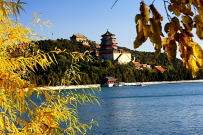In 1840, Britain started the First Opium War against China, and forced the Qing Dynasty to sign the first of many unequal treaties with them beginning with the “Nanjing Treaty”. Learning from Britain, France and America also forced the Qing Dynasty to sign another two unequal treaties called the “Treaty of Whampoa” and “Treaty of Wanghia”. Thereafter, the door to China was forced open by the great western powers. | 
|
In 1851, Emperor Xianfeng came to the throne, and the Taiping Heavenly Kingdom revolted at the same year. Hong Xiuquan, leader of the Taiping army, rose in Jintian Village of Guiping County, Guangxi Province in the name of “God Worshippers”. Two years later, the Taiping army captured Hanyang (Hanyang District of Wuhan City, Hubei Province), Yuezhou (Yueyang City), Hankou (Hankou District of Wuhan City, Hubei Province), Nanjing and several other important southern towns. In 1856, Hong Xiuquan shaped the government system and established Taiping Heavenly Kingdom, making Nanjing as the capital. However, because of the internal split and the suppression of the Qing Dynasty, the Taiping Heavenly Kingdom came to its doom day quickly in 1864.
From 1856 to 1860, Britain, France and some other western courtiers launched the Second Opium War against China. During the war, the united force of Britain and France captured and burnt the Old Summer Palace, an imperial royal summer resort. At the same time, the Qing Dynasty was forced to sign several other unequal treaties with the western powers again, through which China's important trading ports were further opened and a large area of land was ceded.
In 1862, Emperor Xianfeng died of illnesses, and Prince Zaichun took over the throne, who was also known as Emperor Tongzhi. Empress Dowager Cixi killed Su Shun and other regents, and began her nearly half a century's reign behind a curtain. During that period of time, China was defeated by France and Japan in succession, and forced to sign some other unequal treaties. Especially after the failure of the Sino-Japanese War, the signing of Treaty of Shimonoseki made China cede the island of Taiwan and pay a large amount of money to Japan to cover their military costs.
Following Emperor Tongzhi, the state power was still at the helm of Empress Dowager Cixi when Emperor Guangxu came to the throne. In 1898, Emperor Guangxu prepared to carry out capitalist reforms in China, attempting to improve China's backward situation. He accepted the advice of Kang Youwei and Lian Qichao and announced to change the systems in the hope of enriching and strengthening the state. But the reform only lasted for 103 days because of the hindrance caused by Empress Dowager Cixi and some trusted senior ministers. It was historically named “Hundred Days' Reform”.. |